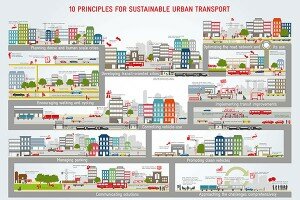Urban density is one of the most discussed concepts in the history of urban design and city planning. It is the first out of ten principles for sustainable urban transport, which are summarised in our new PREZI based on the approach of “avoid-shift-improve”.
During the 19th century urban density was synonymous with narrow, unhygienic housing and living conditions. In the 1930s modernists accused it of promoting social and political unrest. Today, the term urbanity connotes to civic ideals such as smooth and literate and socially capable. From the sixties onwards these ideals became more dominant in public discussion. In 1989 an influential study by Newman and Kenworthy compared 32 cities across the world. The main finding that denser cities have lower car use than sprawling cities is largely accepted by planners today. Planning dense, walkable cities became a new paradigm in city planning:
- Short distances encourage social inclusion and promote sustainable lifestyle. Mixed use city quarters and urban sub centres reduce travel distances between housing, work, and shops. Small urban fabric and sub-centres create a lively environment and save time and costs for travelling. Berlin is a good example. It is also ranked second in the 2014 edition of the YouthfulCities ranking of most attractive places to live for young people between 15 and 29 years old.
- Support programmes such as the German government’s programme Soziale Stadt(social city)create affordable housing in city centres.
- A human scale design holds great potential. Ideally public space is used for people instead of cars; used for walking instead of congestion. Copenhagen is well-known for its enhanced quality of life resulting from an integrated urban and transport redevelopment. Another recent example is the transformation of New York’s Times Square into an urban plaza.
- Transport impact assessment became a common tool for new developments. Modelling the impacts of new policies and development sites on traffic ensures, for example, that the urban fabric is not cut by large transportation corridors that are needed to supply a new site.
- Car-free city quarters increase liveability. One example is Freiburg Vauban: The city district was developed on a former military site and designed according to sustainable standards. Favouring sustainable transport modes by design, 70% of the Vauban’s households do not own a car.
 In the coming weeks, each principle of the PREZI is presented in more detail on www.sutp.org.
In the coming weeks, each principle of the PREZI is presented in more detail on www.sutp.org.
View the PREZI at http://prezi.com/7ufnp8crzc1l/10-principles-sut/
To order a limited number of paper copies of the poster version (format A0) please contact:



